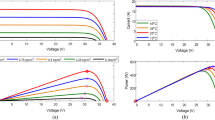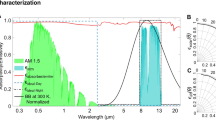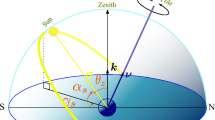Abstract
Concentrating photovoltaic (CPV) systems, which use optical elements to focus light onto small-area solar cells, have the potential to minimize the costs, while improving efficiency, of photovoltaic technology. However, CPV is limited by the need to track the apparent motion of the Sun. This is typically accomplished using high-precision mechanical trackers that rotate the entire module to maintain normal light incidence. These machines are large, heavy and expensive to build and maintain, deterring commercial interest and excluding CPV from the residential market. To avoid this issue, some attention has recently been devoted to the development of tracking-integrated systems, in which tracking is performed inside the CPV module itself. This creates a compact system geometry that could be less expensive and more suitable for rooftop installation than existing CPV trackers. We review the basic tracking principles and concepts exploited in these systems, describe and categorize the existing designs, and discuss the potential impact of tracking integration on CPV cost models and commercial potential.
This is a preview of subscription content, access via your institution
Access options
Subscribe to this journal
Receive 12 digital issues and online access to articles
$119.00 per year
only $9.92 per issue
Buy this article
- Purchase on Springer Link
- Instant access to full article PDF
Prices may be subject to local taxes which are calculated during checkout





Similar content being viewed by others
References
Photovoltaics Report (Fraunhofer-Institut für Solare Energiesysteme, 2015); http://go.nature.com/bbCJU5
Electricity Information 2015 (International Energy Agency, 2015); http://go.nature.com/Sf38pE
Shah, V. & Booream-Phelps, J. Crossing the Chasm: Solar Grid Parity in a Low Oil Price Era (Deutsche Bank, 2015); http://go.nature.com/FjJA67
Philipps, S., Bett, A., Horowitz, K. & Kurtz, S. Current Status of Concentrator Photovoltaic (CPV) Technology (NREL, 2015); http://go.nature.com/BJ4x38
Swanson, R. M. The promise of concentrators. Prog. Photovoltaics 8, 93–111 (2000).
MacMillan, H. et al. 28% efficient GaAs concentrator solar cells. In Conference Record of the Twentieth IEEE 462–468 (IEEE, 1988).
James, L. & Moon, R. GaAs concentrator solar cell. Appl. Phys. Lett. 26, 467–470 (1975).
Yamaguchi, M. III–V compound multi-junction solar cells: present and future. Sol. Energy Mater. Sol. Cells 75, 261–269 (2003).
New world record for solar cell efficiency at 46%. Fraunhofer ISE (1 December 2014); http://go.nature.com/DB4w6q
McGehee, M. An Overview of Solar Cell Technology (Stanford University, 2011); http://go.nature.com/543x7k
Kurtz, S. Opportunities and challenges for development of a mature concentrating photovoltaic power industry. Contract 303, 275–3000 (2012).
Sunpower C7 Tracker Datasheet (Sunpower, 2012); http://go.nature.com/vyfa2x
Kayes, B. M. et al. 27.6% Conversion efficiency, a new record for single-junction solar cells under 1 sun illumination. In 37th IEEE Photovoltaic Specialists Conference (PVSC) 000004–000008 (IEEE, 2011).
Yablonovitch, E., Miller, O. D. & Kurtz, S. R. The opto-electronic physics that broke the efficiency limit in solar cells. In 38th IEEE Photovoltaic Specialists Conference (PVSC) 001556–001559 (IEEE, 2012).
Lee, K., Zimmerman, J. D., Hughes, T. W. & Forrest, S. R. Non-destructive wafer recycling for low-cost thin-film flexible optoelectronics. Adv. Funct. Mater. 24, 4284–4291 (2014).
Lee, K., Lee, J., Mazor, B. A. & Forrest, S. R. Transforming the cost of solar-to-electrical energy conversion: integrating thin-film GaAs solar cells with non-tracking mini-concentrators. Light Sci. Appl. 4, e288 (2015).
Zagolla, V., Tremblay, E. & Moser, C. Proof of principle demonstration of a self-tracking concentrator. Opt. Express 22, A498–A510 (2014). This work demonstrates a planar micro-optic concentrator with reactive tracking achieved using a paraffin wax actuator.
Haysom, J. E., Jafarieh, O., Anis, H., Hinzer, K. & Wright, D. Learning curve analysis of concentrated photovoltaic systems. Prog. Photovoltaics 23, 1678–1686 (2014).
Miles, R., Hynes, K. & Forbes, I. Photovoltaic solar cells: an overview of state-of-the-art cell development and environmental issues. Prog. Cryst. Growth Ch. 51, 1–42 (2005).
Winston, R., Miñano, J. C. & Benitez, P. G. Nonimaging Optics (Academic, 2005).
Smestad, G., Ries, H., Winston, R. & Yablonovitch, E. The thermodynamic limits of light concentrators. Sol. Energy Mater. 21, 99–111 (1990).
Winston, R. & Zhang, W. Pushing concentration of stationary solar concentrators to the limit. Opt. Express 18, A64–A72 (2010).
van Sark, W. G. et al. Luminescent solar concentrators - a review of recent results. Opt. Express 16, 21773–21792 (2008).
Giebink, N. C., Wiederrecht, G. P. & Wasielewski, M. R. Resonance-shifting to circumvent reabsorption loss in luminescent solar concentrators. Nature Photon. 5, 694–701 (2011).
Marion, W. & Wilcox, S. Solar Radiation Data Manual for Flat-Plate and Concentrating Collectors (NREL, 1994); http://go.nature.com/qIRONy
Luque-Heredia, I. in Next Generation of Photovoltaics (eds Cristobal, A., Martí Vega, A. & Luque López, A. ) 61–93 (Springer, 2012).
Smith, S. & Shiao, M. Solar PV Balance of System (BOS) Markets: Technologies, Costs and Leading Companies, 2013–2016 (Green Tech Media, 2012); http://go.nature.com/lX3UdI
Angel, R., Cuerden, B. & Whiteside, A. Lightweight dual-axis tracker designs for dish-based HCPV. AIP Conf. Proc. 1616, 220 (2014).
Bushong, S. Q&A with Mechatron, manufacturer of large solar trackers. Solar Power World (17 December 2014); http://go.nature.com/dkwCoy
Kann, S. U. S. Solar Market Insight Report 2015 Q2 (Green Tech Media, 2015); http://go.nature.com/JfjJMD
Abdallah, S. & Nijmeh, S. Two axes Sun tracking system with PLC control. Energy Convers. Manage. 45, 1931–1939 (2004).
Mousazadeh, H. et al. A review of principle and Sun-tracking methods for maximizing solar systems output. Renew. Sust. Energy Rev. 13, 1800–1818 (2009).
León, N., García, H. & Ramírez, C. Semi-passive solar tracking concentrator. Energy Procedia 57, 275–284 (2014). This work reports beam steering using rotating mirrors.
León, N., Ramírez, C. & García, H. Rotating prism array for solar tracking. Energy Procedia 57, 265–274 (2014).
García, H., Ramírez, C. & León, N. Innovative solar tracking concept by rotating prism array. Int. J. Photoenergy 2014, 807159 (2014). This study shows ray-trace simulation of beam steering with a rotating prism array.
Teng, T.-C. & Lai, W.-C. Planar solar concentrator featuring alignment-free total-internal-reflection collectors and an innovative compound tracker. Opt. Express 22, A1818–A1834 (2014).
Pender, J. G. Motion-free tracking solar concentrator. US patent 6958868 B1 (2005).
Duston, D., Haddock, J., Kokonaski, W., Blum, R. & Colbert, D. Method for light ray steering. US patent 20070157924 A1 (2007).
Valyukh, S., Valyukh, I. & Chigrinov, V. Liquid-crystal based light steering optical elements. Photon. Lett. Pol. 3, 88–90 (2011).
Cheng, J., Park, S. & Chen, C.-L. Optofluidic solar concentrators using electrowetting tracking: concept, design, and characterization. Sol. Energy 89, 152–161 (2013).
Cheng, J. & Chen, C.-L. Adaptive beam tracking and steering via electrowetting-controlled liquid prism. Appl. Phys. Lett. 99, 191108 (2011).
Narasimhan, V., Jiang, D. & Park, S.-Y. Design and optical analyses of an arrayed microfluidic tunable prism panel for enhancing solar energy collection. Appl. Energy 162, 450–459 (2016). This work proposes optical beam steering using liquid prisms controlled by electrowetting, and reports simulations of full hemispheric tracking range.
Kotsidas, P., Chatzi, E. & Modi, V. Stationary nonimaging lenses for solar concentration. Appl. Optics 49, 5183–5191 (2010). This paper reports a wide-acceptance lens (±30° and ±60°) with a PV cell moving on a curved path to track the focal spot.
Kotsidas, P., Modi, V. & Gordon, J. M. Nominally stationary high-concentration solar optics by gradient-index lenses. Opt. Express 19, 2325–2334 (2011). This study shows a ±60° acceptance lens moved on a semi-circular path for Sun tracking, with a stationary solar cell.
Duerr, F., Meuret, Y. & Thienpont, H. Tailored free-form optics with movement to integrate tracking in concentrating photovoltaics. Opt. Express 21, A401–A411 (2013).
Duerr, F., Benítez, P., Miñano, J. C., Meuret, Y. & Thienpont, H. Integrating tracking in concentrating photovoltaics using non-rotational symmetric laterally moving optics. Proc. SPIE 8124, 81240M (2011).
Sweatt, W. et al. Micro-optics for high-efficiency optical performance and simplified tracking for concentrated photovoltaics (CPV). In International Optical Design Conference 2010 ITuC4 (OSA, 2010).
Price, J. S., Sheng, X., Meulblok, B. M., Rogers, J. A. & Giebink, N. C. Wide-angle planar microtracking for quasi-static microcell concentrating photovoltaics. Nature Commun. 6, 6223 (2015). This work shows a refractive–reflective double optic with ±60° tracking range; and tracking done via micromechanical side-to-side translations.
Karp, J. H. & Ford, J. E. Planar micro-optic solar concentration using multiple imaging lenses into a common slab waveguide. Proc. SPIE 7407, 74070D (2009).
Karp, J. H., Tremblay, E. J. & Ford, J. E. Planar micro-optic solar concentrator. Opt. Express 18, 1122–1133 (2010).
Hallas, J. M., Baker, K. A., Karp, J. H., Tremblay, E. J. & Ford, J. E. Two-axis solar tracking accomplished through small lateral translations. Appl. Optics 51, 6117–6124 (2012). This paper reports a planar micro-optic concentrator with micromechanical tracking via side-to-side translation of the waveguide.
Hallas, J. M., Karp, J. H., Tremblay, E. J. & Ford, J. E. Lateral translation micro-tracking of planar micro-optic solar concentrator. Proc. SPIE 7769, 776904 (2010).
Karp, J. H., Tremblay, E. J., Hallas, J. M. & Ford, J. E. Orthogonal and secondary concentration in planar micro-optic solar collectors. Opt. Express 19, A673–A685 (2011).
Liu, C., Wang, Q.-H. & Wang, M.-H. Mirror reflector actuated by liquid droplet. Photon. Technol. Lett. 26, 1077–1080 (2014).
Ma, H. & Wu, L. Horizontally staggered lightguide solar concentrator with lateral displacement tracking for high concentration applications. Appl. Optics 54, 6217–6223 (2015).
Unger, B. L., Schmidt, G. R. & Moore, D. T. Dimpled planar lightguide solar concentrators. In International Optical Design Conference ITuE5P (OSA, 2010).
Wu, H.-Y. & Chu, S.-C. Ray-leakage-free sawtooth-shaped planar lightguide solar concentrators. Opt. Express 21, 20073–20089 (2013).
Liu, Y., Huang, R. & Madsen, C. K. Two-axis tracking using translation stages for a lens-to-channel waveguide solar concentrator. Opt. Express 22, A1567–A1575 (2014).
Selimoglu, O. & Turan, R. Exploration of the horizontally staggered light guides for high concentration CPV applications. Opt. Express 20, 19137–19147 (2012).
Tsou, Y.-S., Chang, K.-H. & Lin, Y.-H. A droplet manipulation on a liquid crystal and polymer composite film as a concentrator and a Sun tracker for a concentrating photovoltaic system. J. Appl. Phys. 113, 244504 (2013).
Klotz, F. et al. Field test results of the Archimedes Photovoltaic V-Trough concentrator system. In Proc. 17th European Photovoltaic Solar Energy Conference and Exhibition 492–495 (ETA-Florence and WIP-Munich, 2001).
Clifford, M. & Eastwood, D. Design of a novel passive solar tracker. Sol. Energy 77, 269–280 (2004).
Baker, K. A., Karp, J. H., Tremblay, E. J., Hallas, J. M. & Ford, J. E. Reactive self-tracking solar concentrators: concept, design, and initial materials characterization. Appl. Optics 51, 1086–1094 (2012).
Tremblay, E. J., Loterie, D. & Moser, C. Thermal phase change actuator for self-tracking solar concentration. Opt. Express 20, A964–A976 (2012).
Zagolla, V., Dominé, D., Tremblay, E. & Moser, C. Self-tracking solar concentrator with an acceptance angle of 32°. Opt. Express 22, A1880–A1894 (2014).
Kozodoy, P. et al. Self-tracking concentrator for photovoltaics. In CLEO: Applications and Technology ATu2J.1 (OSA, 2015).
Zagolla, V., Tremblay, E. & Moser, C. Efficiency of a micro-bubble reflector based, self-adaptive waveguide solar concentrator. Proc. SPIE 8620, 862010 (2013).
Zagolla, V., Tremblay, E. & Moser, C. Light induced fluidic waveguide coupling. Opt. Express 20, A924–A931 (2012).
Schmaelzle, P. H., Whiting, G. L., Martini, J., Fork, D. K. & Maeda, P. Y. Solar energy harvesting device using stimuli-responsive material. US patent 20120132255 A1 (2014).
Peters, M., Goldschmidt, J. C., Kirchartz, T. & Bläsi, B. The photonic light trap—improved light trapping in solar cells by angularly selective filters. Sol. Energy Mater. Sol. Cells 93, 1721–1727 (2009).
Polman, A. & Atwater, H. A. Photonic design principles for ultrahigh-efficiency photovoltaics. Nature Mater. 11, 174–177 (2012).
Kosten, E. D., Atwater, J. H., Parsons, J., Polman, A. & Atwater, H. A. Highly efficient GaAs solar cells by limiting light emission angle. Light Sci. Appl. 2, e45 (2013).
Stefancich, M. et al. Optofluidic approaches to stationary tracking optical concentrator systems. Proc. SPIE 8834, 88340C (2013).
Apostoleris, H., Stefancich, M., Lilliu, S. & Chiesa, M. Sun-tracking optical element realized using thermally activated transparency-switching material. Opt. Express 23, A930–A935 (2015).
Apostoleris, H. N., Chiesa, M. & Stefancich, M. Self-tracking concentrator based on switchable transparency and rejected-ray recycling. Proc. SPIE 9572, 95720A (2015). This paper reports simulations for a mid-concentration ray-recycling concentrator using transparency-switching material with a moving aperture to trap light.
Maragliano, C., Chiesa, M. & Stefancich, M. Point-focus spectral splitting solar concentrator for multiple cells concentrating photovoltaic system. Preprint at http://arxiv.org/abs/1504.00258 (2015).
Jones, J. Global PV Pricing Outlook (Green Tech Media, 2015); http://go.nature.com/YY8JBH
Horowitz, K., Woodhouse, M., Lee, H. & Smestad, G. Bottom-up Cost Analysis of a High Concentration PV Module (NREL, 2015); http://www.nrel.gov/docs/fy15osti/63947.pdf
Acknowledgements
The authors thank Maritsa Kissamitaki for the preparation of the figures.
Author information
Authors and Affiliations
Corresponding author
Ethics declarations
Competing interests
The authors declare no competing financial interests.
Rights and permissions
About this article
Cite this article
Apostoleris, H., Stefancich, M. & Chiesa, M. Tracking-integrated systems for concentrating photovoltaics. Nat Energy 1, 16018 (2016). https://doi.org/10.1038/nenergy.2016.18
Received:
Accepted:
Published:
DOI: https://doi.org/10.1038/nenergy.2016.18
This article is cited by
-
Strategies to improve light utilization in solar fuel synthesis
Nature Energy (2021)
-
Boosting Power Conversion Efficiency of Quantum Dot-Sensitized Solar Cells by Integrating Concentrating Photovoltaic Concept with Double Photoanodes
Nanoscale Research Letters (2020)
-
High irradiance performance of metal halide perovskites for concentrator photovoltaics
Nature Energy (2018)
-
High-concentration planar microtracking photovoltaic system exceeding 30% efficiency
Nature Energy (2017)



